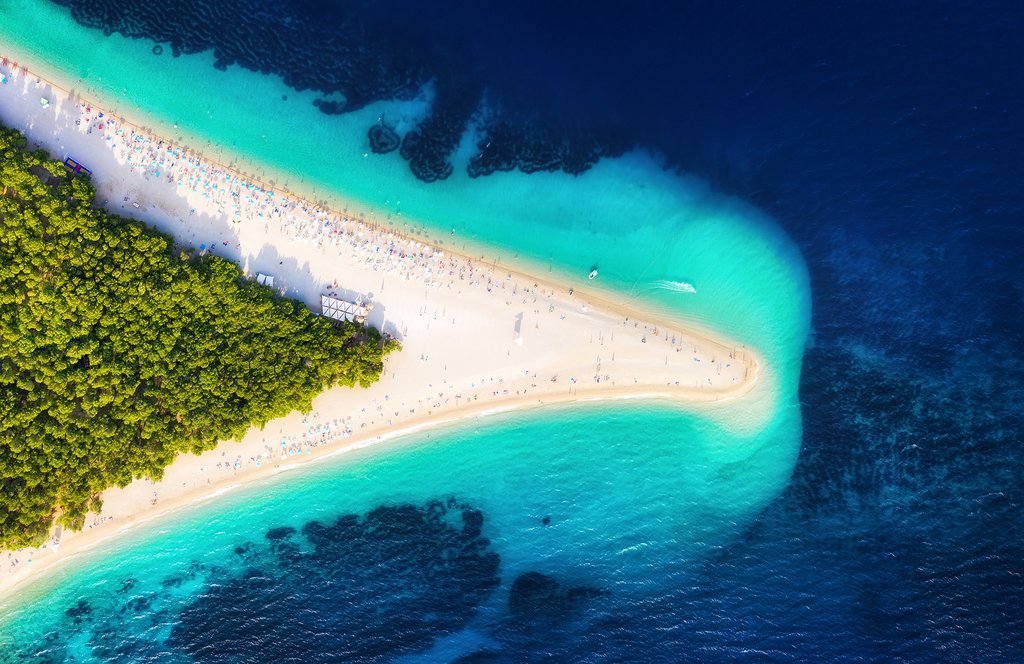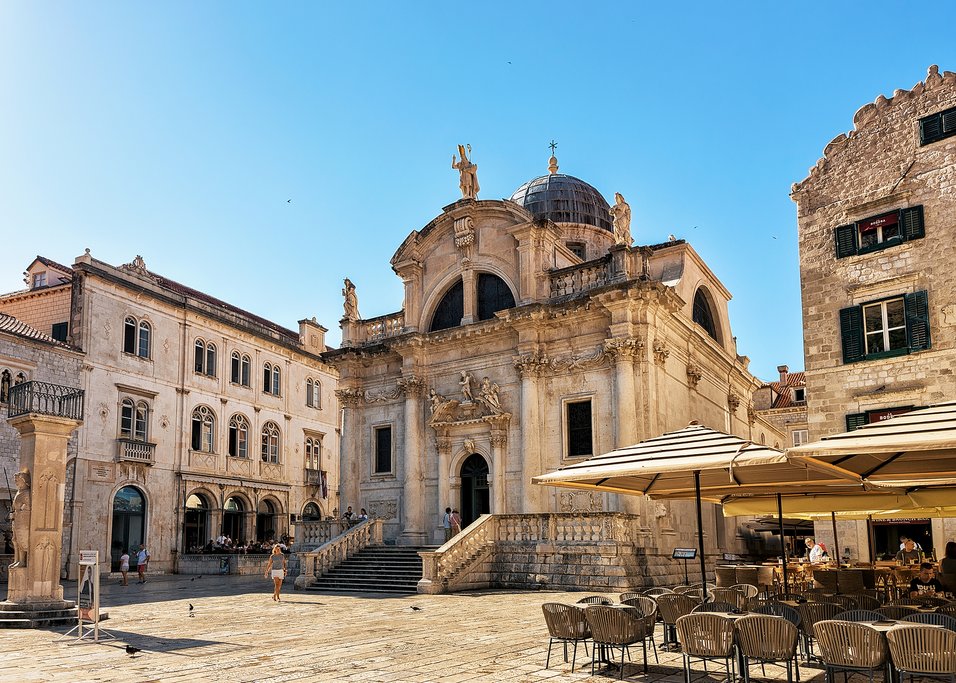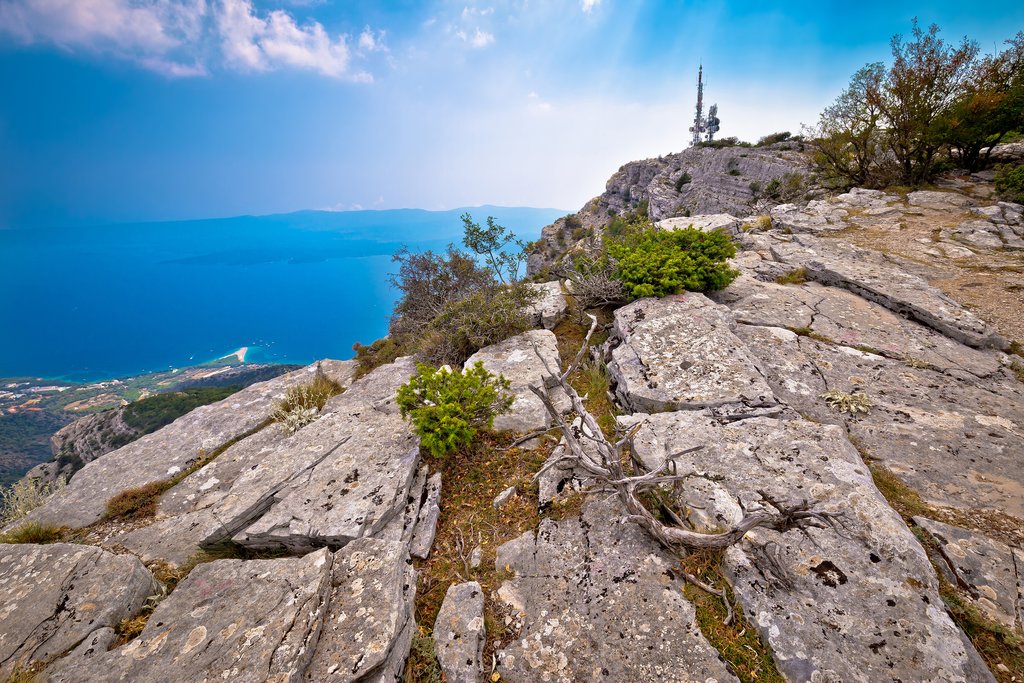Highlights
- Explore the Zagorje countryside and visit the straight-out-of-a storybook, Trakošćan Castle
- Discover the waterfalls and emerald-green lakes of Plitvice Lakes and Krka national parks
- Listen to the sea organ of Zadar and explore its storied alleyways
- Lie out on the white-sand of Brač’s unique v-shaped Zlatni Rat beach
- Drive along the Adriatic coast for a day trip to Montenegro and the Bay of Kotor
Brief Itinerary
| Day | Highlights | Overnight |
|---|---|---|
| Day 1 | Welcome to Zagreb! | Zagreb |
| Day 2 | Scenic Castles of the Zagorje Region | Zagreb |
| Day 3 | Zagreb to Plitvice Lakes National Park | Plitvice Lakes National Park |
| Day 4 | Plitvice Lakes National Park to Zadar | Zadar |
| Day 5 | Explore the Historic Charm of Zadar | Zadar |
| Day 6 | Zadar to Split, Visit Krka National Park | Split |
| Day 7 | Bike Tour of Split | Split |
| Day 8 | Ferry from Split to Brač, Explore Brač | Brač Island |
| Day 9 | Guided Hike to Dragon's Cave, Relax on Zlatni Rat Beach | Brač Island |
| Day 10 | Ferry from Brač to Dubrovnik | Dubrovnik |
| Day 11 | Walking Tour of Dubrovnik | Dubrovnik |
| Day 12 | Day Trip to Montenegro | Dubrovnik |
| Day 13 | Depart Dubrovnik |
Detailed Itinerary
Day 1: Welcome to Zagreb!

Start your adventure from Zagreb, the capital of Croatia. Upon arrival at the airport, you'll be transferred to your hotel to settle in. The rest of the day is yours to spend as you like. The city center is easily walkable and the streets and parks are easy to navigate by foot. All the main attractions and restaurants are within walking distance.
A gem of a European city, Zagreb is at once historic and new. It's filled with leafy green parks and gothic/neo-renaissance buildings, yet there's also modern shopping complexes, outdoor malls, and endless dining and drinking options. Consider heading out on a guided walking tour of the historic heart of the city. This involves walking from the main square to Zagreb's Upper Town and passing through local markets before reaching St. Mark's Square.
Alternatively, you can visit one of the many museums and art galleries, like the Homeland War Museum, the Nikola Tesla Technical Museum, or the ever-popular Museum of Broken Hearts. Or stroll through the city center, enjoying 17th-century neo-baroque architecture found at Zagreb's Art Pavilion and Croatian National Theater.
Zagreb also has a number of beautiful city parks which are great for exploring and people watching, especially in the late afternoon. Maksimir is a great option, with a variety of cafés nearby to pick up a coffee for your stroll.
Day 2: Scenic Castles of the Zagorje Region

Just a few miles northwest of Zagreb lies Zagorje, a bucolic hilly region, dotted with Renaissance and medieval fortresses, numerous baroque castles, and family-run vineyards and farms. It's a memorable, romantic landscape that will take you back in time to a sense of both the aristocratic past and the rural traditional way of life that still exists in Croatia today. A quick day trip from Zagreb allows you to immerse yourself in this beautiful region.
Find your way to Trakošćan Castle, a good example of one of these storybook locales, as it sits perched on a hill adjacent to a glassy lake. The castle, a historic landmark, was built in the 14th century as a defensive fortress but was later used as a home for aristocratic Croatian families. On a tour, you can not only visit the castle grounds but you'll go inside and explore all four floors, which function as a museum with permanent exhibitions.
Afterward, visit Veliki Tabor Castle, which is located just southwest of Trakošćan. This gothic-renaissance castle dates to the 16th century and also sits on a green hill overlooking the fertile countryside. It was originally built for a noble Hungarian family and its fortifications were designed to defend against Turkish invaders. A tour of Veliki includes visits to the towers, guardhouses, and inner courtyard plus a small museum featuring exhibitions of medieval artifacts like armor, weapons, and paintings.
Apart from castles, explore nearby old villages, like Kumrovec, where you'll find restored peasants' houses from the 19th century. These are great areas to browse local craft shops and enjoy some traditional country cuisine like grilled lamb, meat skewers, and veal stuffed with cheese and ham. Kumrovec is most well known for being the birthplace of Marshal Josip Broz Tito, the communist revolutionary who was President of Yugoslavia from 1953 to 1980.
Day 3: Zagreb to Plitvice Lakes National Park

Today, you'll make the drive south to Plitvice Lakes National Park, one of Croatia's most popular national parks. Along the way, make a point to stop at Rastoke. Rastoke is a small village known for its old watermills and beautiful waterfalls as two rivers converge in the area. This is a nice precursor of the sights to come at Plitvice Lakes.
A short drive later, you'll arrive at Plitvice Lakes National Park in the early afternoon and can explore the park at your leisure. A must-visit for any traveler to Croatia, the UNESCO-protected park is comprised of an exquisite collection of 16 glassy emerald green and blue travertine lakes, more than 90 cascading waterfalls that seemingly cover every corner of the park, and numerous caves. The terraced lakes are surrounded by beech and pine forests and are home to extensive wildlife.
Choose one of eight different hiking trails, ranging from three to eight hours in duration, where the upper lakes tend to be less crowded during the peak season. You may wish to bring a bought lunch (and a bottle of wine!) with you to enjoy a picnic. Tickets are purchased at the entrance of the Park.
Driving time (Zagreb to Rastoke): 1.5-2 hours
Driving time (Rastoke to Plitvice): 30 minutes
Day 4: Plitvice Lakes National Park to Zadar

In the morning, continue your drive south from Plitvice to the ancient Roman city of Zadar. A historical center of the Dalmatian Coast, Zadar is famous for its picturesque coastline full of islands and vibrant blue waters, as well as fresh seafood and unforgettable sunsets.
Take the rest of the day to relax and explore. You may wish to stroll along Zadar's Riva, a wide ribbon of stone paths bordered by a grassy park on one side and the sea on the other. It runs along Old Town’s waterfront, where it comes alive at night with vendors and Dalmatian a capella groups called Klapa that serenade the passersby, including folks on yachts who dock there.
Take in a legendary sunset (Alfred Hitchcock is on record saying they're the best in Zadar) from Café Brazil before discovering the pretty patterned lights of the Monument to the Sun while listening to the nearby Sea Organ.
Driving time: 1.5-2 hours
Day 5: Explore the Historic Charm of Zadar

Today is yours to explore the often-overlooked star of Dalmatia. The largest city on Dalmatia's northern coast, there's a lot to see and do. You can stroll the marble streets of Zadar's famous Old Town—once the mightiest fortress city in the Venetian Republic—or wander beyond its Venetian gates, past stone walls and examples of Roman and Byzantine architecture in the form of the 1st century remains of the Roman Forum and the 9th-century Church of St Donatus.
Another noteworthy site to check out is the baroque St. Simeon Church for a sighting of the Queen Elizabeth-commissioned sarcophagus. Be sure to stop for lunch and a glass of wine in the center of town at a konoba restaurant like Stomorica.
After touring the city by day, come to the waterfront just before dusk to witness another of Dalmatia's most beautiful sunsets. During this time, you can marvel at Croatian artist, Nikola Bašić's 72-foot Monument to the Sun art feature while you listen to the nearby Sea Organ play its unending melody, fueled by the ebb and flow of the Adriatic Sea's current. And in the evening, partake of Zadar's to-die-for seafood. There are plenty of great restaurants in the historic center.
Chat with a local specialist who can help organize your trip.
Day 6: Zadar to Split, Visit Krka National Park

After breakfast, you'll drive south toward Split, stopping at Krka National Park and the charming coastal towns of Primošten and Trogir. With seven waterfalls—the largest and most impressive being Skradinski Buk—Krka National Park is one of eight national parks in Croatia. The Krka River, another highlight of the park, carves through the limestone and creates a spectacular canyon on its 44-mile journey (70 km) from the foothills of the Dinaric Alps to Šibenik.
Follow the winding wooden paths that traverse emerald pools to viewpoints of the majestic series of falls and enjoy a quick swim if the mood strikes. One great section to explore starts at Skradinski Buk. From there, head to Roški Slap, where you can take a short walk across the river to a small set of rapids, said to resemble a pearl necklace from above. At Roški Slap, you can stop to grab a bite to eat of locally produced prosciutto, cheese, and seasonal salads.
Come mid-afternoon, travel further south to Split, settling into your hotel before taking the rest of the afternoon to wander its historic center. Start at Pjaca Square for pretty views of white marble tiles, the Iron Gate (the western entrance to Diocletian's Palace), a Romanesque clock tower with the remains of a medieval sundial, and the 15th-century Town Hall. Next, visit the popular Voćni trg or Fruit Square to enjoy renaissance architecture, influenced during Split's Venetian era.
For a bit of shopping and a bite to eat head to Marmont Street, though you'll want to find your way to the waterfront to catch the sunset.
Driving time (Zadar to Krka): 1-2 hours
Driving time (Krka to Split): 1.5 hours
Day 7: Bike Tour of Split

One of the best ways to see the historic city of Split is on two wheels. This three-hour, 12-mile (20 km) cycling excursion takes place almost exclusively on the city's waterfront as you visit charming little bays, harbors, and pebbly beaches. Not to worry, though, as you'll also stop in at some must-visit sites like the Diocletian's Palace and Marjan Park, a pine forest on the western end of the peninsula that features scenic viewpoints.
Despite being a half-day outing, this is an easy excursion that requires a low level of physical fitness. Depending on the schedule, it's also possible to include additional stops on the itinerary, including museums and restaurants.
Day 8: Ferry from Split to Brač, Explore Brač

This morning, board a public ferry bound for the port town of Bol on Brač Island and check into your hotel. The largest of the central Dalmatian islands, Brač is bursting with historic sites dating back to ancient Greece and the Middle Ages.
Take the day to explore the island by car and discover coastal towns and villages, and older settlements in the interior of the island. Stop in Pučišća and visit the only stone masonry school in Europe (their sculptures scattered throughout Bol). Discover the centuries-old lapidary tradition as you watch the students bring Brač stone to life. Next, drive up to the highest peak on the island, Vidova Gora, for all-encompassing views of Bol, Zlatni Rat beach, and the Adriatic.
Continue the short trip west, winding your way to the UNESCO-protected site and now a museum, the Blaca Monastery (Pustinja Blaca). An impressive hermitage built around a cave by two monks fleeing persecution. And when it's time, return to Bol for a leisurely dinner, perhaps choosing a restaurant with views of the sea, like Terasa Santo or Vendetta.
Ferry time (Split to Brač): 1.5 hours
Day 9: Guided Hike to Dragon's Cave, Relax on Zlatni Rat Beach

Step outside your hotel early in the morning and visit the King's Stairs, located in the heart of Bol, to mingle with the locals and buy fresh fruit and veg from the local market. Afterward, meet your guide and drive to Dragon's Cave (Zmajeva Spilja), just 3 miles west of Bol for a hike to explore the impressive Christian and pagan reliefs carved into the cave walls by a 15th-century friar.
From here, return to your hotel to grab your swimsuit before setting out along the Bol Promenade, lined with Brač stone and shaded with pine trees, to Croatia's pretties beach, Zlatni Rat. Enjoy the rest of the afternoon relaxing or take advantage of the maestral winds and windsurf just offshore. A geographical phenomenon, Zlatni Rat protrudes over 1,641 feet (500 m) into the Adriatic Sea in a v-shape, surrounded by deep blue and turquoise water. The shape of the beach changes with the wind and water current, further adding to its uniqueness.
Day 10: Ferry from Brač to Dubrovnik

In the morning, you'll catch a public ferry to Dubrovnik and make your way to your hotel to check in.
Often referred to as the "Pearl of the Adriatic," Dubrovnik is a world-renowned city of exceptional charm. Take the time to explore its 16th-century stone walls, including the Minceta, Lovrijenac and Revelin fortresses, visit Onofrio's Fountain and the Church of St. Blaise (St. Vlaho), and stroll along the limestone-paved Stradun, Dubrovnik's main street to get your bearings. Dubrovnik offers excellent nightlife and some of Croatia's best restaurants and wine bars.
The remainder of the day will be at your leisure, allowing time for you to wander and explore this magical city. Depending on when you arrive, you may have time to hop aboard a cable car and ride to the top of Srđ Mountain for stunning vistas of Dubrovnik and the nearby Elafiti Islands. Here you can explore the 19th-century Fort Imperijal (built during the Napoleonic Wars) before stretching your legs and walking back down the hill enjoying views of the city below.
Ferry time (Brač to Dubrovnik): 4.5 hours
Day 11: Walking Tour of Dubrovnik

Start your day early (around 8 am) to avoid the crowds and to embark on a tour of Dubrovnik where you'll meet your expert guide outside the entrance to the medieval city at the 16th-century Pile Gate. Entering Old Town, you'll uncover centuries of the city's rich history as you listen to stories of local life and legends and of the importance Dubrovnik once held in the era of the Republic. Highlights include Onofrio's Fountain, the 15th century Rector's Palace, Luza Square, the Church of St. Blaise (St. Vlaho), and the café-lined streets of Brsalje Street.
After touring the streets and alleys, you'll head for Lovrijenac Fortress as well as the city's impressive defensive walls, the second-largest set of city walls in the world. At certain places the wall rises 75 feet high, offering excellent vantage points for photos of the coastline.
For the rest of the afternoon, explore Dubrovnik and its surroundings on your own or enjoy the afternoon sun on the nearby beaches. Come early evening, you can get stunning panoramic views over the city and Adriatic by taking the cable car up to Srđ Mountain before descending back down for dinner at one of Dubrovnik's great restaurants.
Day 12: Day Trip to Montenegro

Today you'll get to check off another country on your travel bucket list as you make a day trip to Montenegro. This Balkan nation borders Croatia and Bosnia and Herzegovina to the south and is known for the beautiful beaches and medieval villages along its Adriatic coastline.
You'll want to get an early start to allow time for the border crossing. After crossing over, you'll enjoy a scenic drive around the Bay of Kotor before stopping at the village of Perast, which is a little bit of Venice on the Adriatic. From here, you'll make the 20-minute drive to stop and explore the medieval coastal village of Kotor. This UNESCO World Heritage Site is built on a sloping mountain and abounds with Venetian palaces and Romanesque churches.
Kotor is also an ancient fortress town as evidenced by the medieval stone ramparts that run up the mountain to the Fortress of St. John, which dates to the 6th century. You can reach this fortress by hiking up some 1,350 steps from town to a height of roughly 820 feet (250 m). When you're ready, find your way back to Dubrovnik.
Know that you can do this trip on your own (with a rental car) or hire the services of a private driver. Navigating the border crossing and finding parking in Montenegro can be challenging, however, so it's recommended that you opt for a private driver.
Driving time (Dubrovnik to Perast): 2 hours
Driving time (Kotor to Dubrovnik): 2 hours
Day 13: Depart Dubrovnik

Depending on when you depart, you may have time to visit one of Dubrovnik's museums, like the Franciscan Monastery and Museum. This large complex houses many treasures, including the world's third oldest pharmacy dating from 1317.
Alternatively, for a collection of 15,000 pieces of interesting works, visit the Rector's Palace and Cultural Historical Museum. Wander this well-preserved palace-turned-museum and explore its exhibits, some detailing life in the Republic of Ragusa during medieval times.
The drive to the airport from Dubrovnik takes around 45 minutes with normal traffic.
